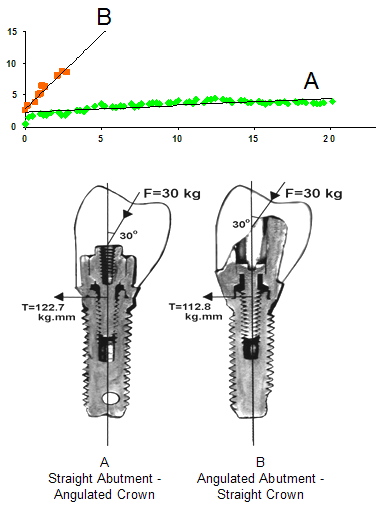 A comparative study was conducted to investigate the stability of two different abutments and abutment screws in single implant restoration. Two cemented single crowns, each angulated at 15? to a 30 kg vertical load and 15? to the implant axis, were fabricated using: (A) straight abutment with an angulated crown, and (B) straight crown with an angulated abutment.A mathematical vector analysis of the two specimens indicated that arrangement (A) has a torque of 122kg.mm at the abutment-implant interface, while arrangement (B) has a smaller torque of 112kg.mm.In the functional analysis using cyclic fatigue loading, crown mobility was assessed using PTV values. The endpoint was defined either when PTV of
the crown was greater than 10, or when the samples reached 20 M cycles. Arrangement (A) typically ran out well over 20 million cycles while arrangement (B) failed on average at 2.6 million cycles for the same given load. The result of this experiment shows that arrangement (A) is at least 7 times more stable than arrangement (B). This difference in crown mobility during cyclic fatigue loading is directly related to the design of the abutment screw and not related to the torque at the abutment-implant interface or cementation. A comparative study was conducted to investigate the stability of two different abutments and abutment screws in single implant restoration. Two cemented single crowns, each angulated at 15? to a 30 kg vertical load and 15? to the implant axis, were fabricated using: (A) straight abutment with an angulated crown, and (B) straight crown with an angulated abutment.A mathematical vector analysis of the two specimens indicated that arrangement (A) has a torque of 122kg.mm at the abutment-implant interface, while arrangement (B) has a smaller torque of 112kg.mm.In the functional analysis using cyclic fatigue loading, crown mobility was assessed using PTV values. The endpoint was defined either when PTV of
the crown was greater than 10, or when the samples reached 20 M cycles. Arrangement (A) typically ran out well over 20 million cycles while arrangement (B) failed on average at 2.6 million cycles for the same given load. The result of this experiment shows that arrangement (A) is at least 7 times more stable than arrangement (B). This difference in crown mobility during cyclic fatigue loading is directly related to the design of the abutment screw and not related to the torque at the abutment-implant interface or cementation.
1. Andersson B, ?dman P, Boss A, J?rn¨Ļus L. Mechanical Testing of Superstructures on the CeraOne Abutment in the Br?nemark System. Int J Oral Maxillofac Implants 1994; 9:665-672.2. Weinberg LA, Kruger
B. A Comparison of Implant/Prosthesis Loading With Four Clinical Variables. Int J Prosthodont 1995; 8:421-432.�
Supported in part by National Research Council of Canada # 28048U.?
|